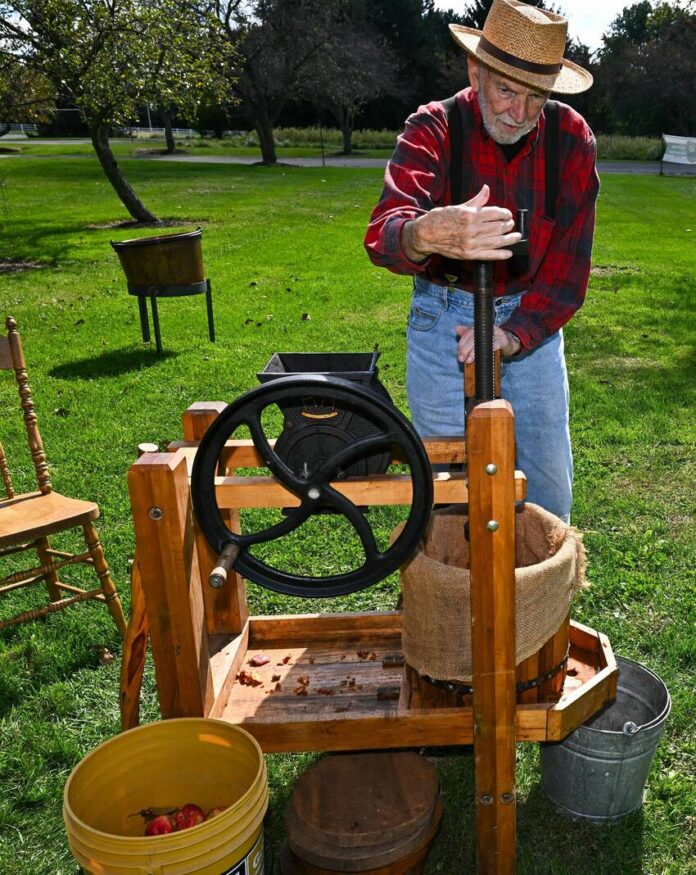LIMA — For one afternoon, life at the Allen County Farm Park on Slabtown Road was more about hand-powered cider presses than handheld cell phones.
The park was the site of early-1800s re-enactors Sunday. There were demonstrations on food preservation, food preparation and the use of various herbs.
Michael Gentry of Lima portrayed the role of a “long hunter,” men who hunted for several days before returning to the fort with game ready to be processed. Deer, turkey and various birds might be among those items hunted and used to supply food for future months.
Meat was often smoked in the fall when temperatures were cooler. Tom Sciranka discussed the process of primitive meat preparation with attendees at the smokehouse. The 1800s smokehouse was restored through donations from family and friends in honor and memory of Rodney LaFollette, who died in 2007. Linda Sears, daughter of Marge and the late Rodney LaFollette, discussed her family’s decision to provide donations for the smokehouse restoration.
“Mom and Dad raised us in nature,” Sears said. “He was a scoutmaster in Bath [Township]. When he passed away, there was an opportunity to do something meaningful.”
Sciranka described the smoking process, saying you, “need more smoke than heat.” Typically meat was placed in a brine solution prior to being smoked. A 25-pound ham took three days to brine. The brine solution, typically consisting of water, salt and sugar and “thick enough to float an egg,” helped to prevent spoilage of the meat. For meats with a “wilder” taste, more sugar would be used. After smoking, meat would be wrapped or encased in wood ash to “keep the bugs out.” Coating meat with molasses and black pepper served as an alternate method of protecting the meat. According to Sciranka, properly cured, smoked and stored meat can last for years without refrigeration.
Demonstrating the use of a manual press for making apple cider, Denny Bucholtz said it is best to make the cider with a variety of apples in order to achieve the best flavor.
“It takes about a bushel of apples to make two gallons [of cider],” he said.
The manual press he used during Sunday’s demonstration is still in use today by those in the Amish community, according to Bucholtz.
While demonstrating the use of a washboard to 10-year-old Keegan Niesen, Melissa Kiracofe recalled observing the same method of doing laundry at her grandmother’s home when she was a young girl. Kiracofe also demonstrated how clothes were ironed in the 19th century. The conventional solid metal clothes irons weighed between five and 10 pounds and had to be heated on a stove. Kiracofe demonstrated a later model clothes iron with a detachable rounded wooden handle. The handle design, Kiracofe was quick to add, “was invented by a woman.” Mary Florence Potts from Iowa obtained the patent for the iron in 1871. Advantages of Potts’s invention were that the iron base could be placed on a heated stove top and the handle removed at the time to stay away and cool while the base heated. This prevented burned fingers that often happened with the conventional all-metal clothes iron. It also enabled ironing to resume immediately after a base had cooled.
“Two hundred years ago, life centered around food,” Johnny Appleseed Metro Park District volunteer coordinator Chris Fetzer said. “People were raising food, preserving and preparing food and eating food, so most of the day was spent with food.” She also indicated that the average American consumed 12,000 to 15,000 calories per day at that time. At the park, she demonstrated making whipping cream.
“Cream is very fat and the more you agitate it, the thicker it gets,” she said. “It can go from a liquid [cream] to a solid [butter] if you continue to whip it.”
Visitors to the Farm Park were able to sample the fresh whipping cream on slices of ginger cake.
Herbs were used for food and medicinal purposes in the 19th century. Marge LaFollette, the widow of Rodney, added fresh herbs to butter for a delicious herbal butter that was spread onto “griddled bread.” Appalachian families were credited with adding grated hard sweet corn into the basic cornbread mixture to make “griddled bread.” Some cooks prefer to add parsley and chives to their cornbread mixture.
LaFollette also indicated that herbs were used for medicinal purposes. Adding sage to honey was a common treatment for sore throats. She also discussed use of the perennial comfrey plant to make, “comfrey salve,” a home remedy for arthritis and for “drawing slivers out of fingers.” According to LaFollette, “rubbing the ‘mucilage’ from the plant directly onto bee stings, takes the sting right out.” The plant leaves were also used to treat diarrhea in baby calves.
Strands of dried herbs, beans and mushrooms were on display in one of the buildings at the Farm Park, revealing another method of food preservation. Dehydration, a simple and commonly-used method of food preservation, is still performed today.
Although processes have been modernized, many of the methods of food preservation from the 19th century are still in use today.
Reach the newsroom at 419-222-6397 or at [email protected].







